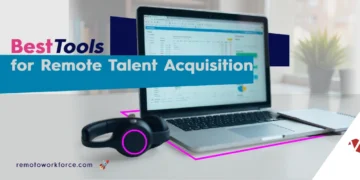Welcoming a new team member in a remote setting involves much more than sending login credentials and a calendar invite. Onboarding shapes the first impression, sets expectations, and directly influences how quickly someone contributes and feels part of the team. Without a shared office, every step must be planned to create structure and foster a sense of belonging.
This blog post will guide you through the key components of remote onboarding that support productivity and connection from day one. Whether you lead a fast-growing startup or manage a globally distributed team, a strong onboarding process helps people hit the ground running.
Start Before Day One to Create Momentum
The best onboarding experiences begin before the first official day. Communication between the offer letter and the start date builds anticipation and trust. Silence during this time can lead to second-guessing, while thoughtful outreach signals professionalism and care.
Send a welcome message that includes a schedule, an introduction to key tools, and a short overview of what to expect during the first week. Assigning a point of contact helps answer any initial questions and gives the new hire a sense of support even before they begin.
Prepare equipment, accounts, and permissions in advance. Whether you’re shipping laptops or configuring access to internal platforms, make sure everything works by the time they log in. When things run smoothly on day one, it reflects well on your internal systems and builds confidence in the team.
Build Human Connections from the Start
Remote workers often face early feelings of isolation. Without in-person greetings or informal chats, the need for meaningful interaction becomes even more important. Focusing on personal connections in the first few days helps new hires feel seen and included.
Use video to create real-time interactions. Schedule one-on-one meetings with teammates and managers during the first week. These short conversations provide context, build familiarity, and create early bonds that make work more collaborative.
Introduce a buddy system as well. This person can check in regularly, answer questions, and help the new hire understand informal team dynamics. A simple chat every other day goes a long way in reinforcing a sense of community during the transition into a new role.
Give the First Week a Clear Structure
New hires need structure, especially in remote settings. Too much flexibility without guidance can cause confusion or slow momentum. A well-planned first week provides orientation, direction, and an early sense of achievement.
Start with a welcome session that introduces company values, tools, communication norms, and security procedures. Instead of cramming everything into a single meeting, break the information into digestible blocks across several days. This helps with retention and prevents overwhelm.
Outline small, achievable goals for the week. Examples might include setting up workspaces, completing onboarding modules, or submitting a self-introduction. These actions provide immediate focus and create a rhythm for independent work while reinforcing the company’s workflow and culture.
Make Expectations Visible and Transparent
Clarity is one of the most important elements of remote onboarding. Without hallway conversations or visual cues, assumptions can quickly lead to missteps. Managers must actively define expectations and share the rules that guide decision-making and performance.
Have a dedicated conversation to align on what success looks like in the role. Go beyond responsibilities. Talk about performance metrics, feedback loops, timelines, and team dynamics. These conversations help the new hire understand what matters most and how to approach their work.
Create and maintain a central knowledge base. This should include onboarding guides, frequently asked questions, process documentation, and links to important tools. Easy access to information empowers new hires to solve problems independently and reduces unnecessary delays.
Add Milestones That Keep Engagement High
Remote onboarding should not end after the first week. A consistent cadence of check-ins helps ensure continued alignment, engagement, and progress. Without follow-up, new hires can drift into uncertainty or disconnect from the team’s rhythm.
Plan milestone checkpoints at key intervals such as day 7, day 30, day 60, and day 90. Use these moments to evaluate progress, clarify expectations, and ask for feedback. These meetings provide space for reflection and adjustment while reinforcing your investment in the employee’s success.
Celebrate achievements at each stage. A simple mention in a team meeting or a direct message from leadership can validate effort and strengthen emotional connection. Recognition reinforces commitment and creates momentum for the next phase of work.
Connect the New Hire to Team Culture
Company culture is more than a set of values on a slide. It is reflected in how teams communicate, solve problems, and support each other. Remote onboarding should provide multiple opportunities for new hires to observe and participate in cultural practices.
Talk openly about team rituals, decision-making styles, and ways of working. Share stories that illustrate what your company values in real situations. These examples bring culture to life and help new employees adapt more quickly.
Invite them to regular team activities. Whether you host virtual coffee chats, all-hands meetings, or async project updates, inclusion in these routines helps people feel part of something larger. Culture becomes real through participation and repetition.
Use Tools That Enable, Not Overwhelm
Remote onboarding works best when technology supports clarity and connection. However, introducing too many platforms at once can create confusion. A simplified toolkit helps new hires learn faster and focus on the work that matters.
Choose a single location for all onboarding documents. Tools like Notion, Google Drive, or Confluence can act as central hubs for policies, schedules, and resources. Organize the layout clearly and remove outdated files to avoid distractions.
Introduce project management and communication tools gradually. Match tool adoption with role-specific needs rather than forcing immediate mastery of every system. When tools are introduced in context, they become assets rather than obstacles.
Turn Onboarding into a Strategic Advantage
Strong onboarding experiences build more than just competence. They foster loyalty, boost confidence, and create alignment between individuals and teams. When done with care, onboarding becomes a key driver of productivity and retention in a remote-first environment.
Remote teams face unique challenges, but they also benefit from intentionality. Without informal touchpoints, structure and connection become essential. The quality of the first few weeks directly affects the likelihood of long-term success.
Treat onboarding as an investment in your people. When new hires feel supported, informed, and welcomed, they show up with energy and purpose. That momentum carries into everything they contribute going forward.














